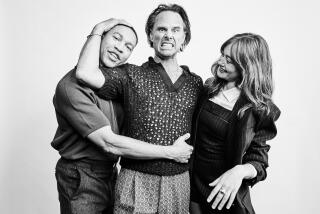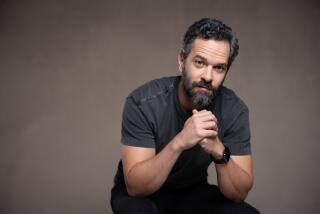‘The Last of Us Part 2’: A queer hero’s emotional battle and a moral test over killing dogs
- Share via
“The Last of Us Part 2” will, at times, be rather difficult. No, not in the standard video game definition of easy or hard. The game’s director, Neil Druckmann, promises that the team at Naughty Dog has included more accessibility options than ever to ensure that the game, due Feb. 21 for Sony’s PlayStation 4, is fit for any play style or player limitation.
Instead, “The Last of Us Part 2” will be a challenge because it will offer plenty of potentially uncomfortable opportunities. One of its core goals is to intimately connect with the player by using the emotional turmoil suffered by its lead character, Ellie, now 19. Those who played the first game know that her childhood and early teen years were spent surviving the horrors of a zombie-like apocalypse and dealing with the aftereffects of life in such a hellscape.
Among the questions the new game will explore: Is it possible for her to be vulnerable? And what is lost, emotionally and literally, with becoming unguarded?
Zooming out, Druckmann at a press event this week said it’s a game about revenge, one that aims to dive deep into trauma and self-guided justice. When does it feel good, and when does it completely corrupt someone? Weighty questions, but Druckmann and the Sony-owned, Santa Monica-based studio Naughty Dog have earned the right to explore them. Since its 2014 release, “The Last of Us” has sold more than 17 million copies, winning fans more for exploring interpersonal tension than it did for shooting grotesque, infected humans.
As for the gruff survivor Joel, who was the primary playable character of the first game — he was a parent figure for Ellie, whose immunity to the infection pitched her as key to human survival — we see less of him in “The Last of Us Part 2.” Their relationship is now “strained,” Druckmann said, and he teased that the second game in the series will build to philosophical questions that expand on those of the first one, which largely centered on the idea of ends justifying the means.
The themes of “The Last of Us Part 2” are personal to its creators, said Druckmann, who crafted the story closely with writer and actress Halley Gross, who worked on several episodes of HBO’s “Westworld” as a story editor and writer.
“I was born in Israel,” Druckmann said. “I come from a part of the world that is often looked at and thought about as this idea of the cycle of violence. And so that has been topical for me for a very long time. But actually, the example I want to use is when I was a teenager. I watched the news, and there was a story about a South American country, a fisherman, hunting dolphins.”
Druckmann then describes a horrific scene of animal abuse — the fisherman essentially punching the dolphin anytime it resisted. On shore, Druckmann said, a group of children came at the dolphin with knives, mutilating the animal.
“It brutally affected me on this deep level,” he said. “I had thoughts like, ‘I would want to make every single one of these people pay, including the kids.’ What a dark thought to have in your mind. And I was like, ‘What is that? What is it that we all have?’ We all have those moments where our mind tips in this very primitive, probably prehistoric way in which we survive. It felt like we could make a game that explores the different facets of what that means.”
Naughty Dog previewed two extended scenes from the game, one that explores the relationship between Ellie and her recently introduced friend Dina, and one that showed Ellie hell-bent on revenge. Early in the game, we get a glimpse of Ellie’s daily life, the regular patrols she undertakes in protecting a Wyoming encampment from infected humans.
While there were moments of violence, this was largely an opportunity to get to know Ellie and where she is at the start of “The Last of Us Part 2” — a young woman alternately embracing and rejecting her romantic feelings for Dina. Ellie brushes off Dina’s compliments — “We’re here to kill infected, not look fancy,” she says.
In an earlier trailer, one revealed at 2018’s Electronic Entertainment Expo, Ellie and Dina shared a kiss, a rare video-game quiet moment between two women that made the argument that good old-fashioned storytelling still tops slick gameplay and larger-than-life digital effects. That was true again in this week’s preview: The most harrowing scene was one not involving gunplay but an all-enveloping blizzard in which Ellie and Dina were briefly separated and the game distorted all sense of place. The most memorable moment occurred when Ellie and Dina finally had a chance to relax, with the two playfully rating their kiss from the night before. “I give it a six,” said Dina, flirtatiously shrugging it off.
“It makes the action more intense and more interesting when you’re not at 11 the whole time,” Druckmann said. “With ‘The Last of Us,’ so much of that game is about really small, quiet relationships. You can’t establish that if you’re being shot at and hunted. Then, it’s all about survival. Yeah, there’s something about bonding and working together, but you can’t slow things down and talk about what we like or play guitar or play a game — all these things that we sprinkle throughout ‘The Last of Us 2.’ They’re just as important, and sometimes more so, than the big spectacle.”
In fact, “The Last of Us Part 2” appears to discourage the player from seeking out big blockbuster moments. As in the first one, resources are scarce, and in a later moment — one taking place in an encampment of xenophobic humans in the Pacific Northwest — it’s best to avoid the action, or you’ll quickly become overwhelmed. The implication at the media event and in a new teaser is that Ellie seeks vengeance for some harm that comes to Dina, although Druckmann is already promising many surprises in the game’s second half.
One thing is certain. A premium was placed on finding a closer marriage between gameplay — the act of pressing a button on a controller — and a character’s actions. In an effort to find ways to iterate on an enemy, Naughty Dog introduced smell to the game’s bag of tricks — Ellie now can be tracked by human-hunting dogs. Since so much of the game involved crawling through the wilderness, one has to learn how to throw off its tracks a pup trained to be evil.
Here is one of many places the game may make players uncomfortable. “Something about dogs, and the killing of a dog and being violent against a dog, triggers people in different ways,” Druckmann said. “When the dog yelps when you stab it or shoot it, it makes you feel dirty. There’s an emotional weight to it.”
Druckmann isn’t kidding. The first time I killed a dog in “The Last of Us Part 2,” I set down my controller and sat in silence for a moment on the verge of tears, this despite the fact that the dog was at Ellie’s throat. How, for instance, did Druckmann decide the studio could get away with killing a dog?
“I’ll tell you something really interesting that will make you feel even worse,” he said. “You didn’t have to kill any of those dogs. You can go the whole [game] without killing a single dog. You were cornered. You were in a situation where you felt you had to, or maybe you chose to because you chose the easier path.”
But it was, Druckmann said, a lengthy discussion for the studio.
“We got into a debate,” he said. “In focus-testing the game, some testers had issues killing the dogs. So do we downplay it? Do we just remove the yelping and make it quicker? I said, ‘No.’ We are making a story about the cycle of violence and we have to honor that. We are doing a disservice if we try to appeal to a larger group to make them more comfortable. A lot of the story, and what’s unique to video games, is the actions will make you uncomfortable. We’re asking you to participate in actions. That, to me, is the magic juice that’s unique to this medium.”
In a way, feeling that pain is something of a success for Druckmann and his team. Too often, video games have made violent acts simply feel arcade-like, as if there is no consequence. Consider “The Last of Us,” and now its sequel, an experiment in making players care in grand, big-budget violent games.
“The intention is to treat the violence as realistically as we can,” he said. “Real violence is very uncomfortable, unlike stylized violence. People think if you have war that makes it bad. But sometimes, it’s cartoon-y. If I watch ‘Army of Darkness,’ it doesn’t affect me the same way as ‘Saving Private Ryan.’
“It can be off-putting and unsettling at the same time,” he continued, “and ultimately thought-provoking.”
More to Read
The biggest entertainment stories
Get our big stories about Hollywood, film, television, music, arts, culture and more right in your inbox as soon as they publish.
You may occasionally receive promotional content from the Los Angeles Times.











